Available Procedures for Skin Care
Acne, commonly called pimples, occurs during the acme of life, in other words the best or peak years of life.95% of all people develop some acne between the ages of 15 and 35.It can begin earlier than 15 years of age or last later than 35. Once acne begins, it runs its own course spanning a period 4 to 10 years or more and then pimples will cease to appear.
When you consult a dermatologist, the plan is to treat you till the pimples disappear and then teach you a method of caring for your skin so that acne is kept in check till such time as it ceases to appear on its own.
Pimples are not infectious, do not indicate poor hygiene, impure blood, constipation or ill health. There is no diet for people with acne. Chocolates and colas’ may be avoided to save money and also because they are unnecessary from a nutritional point of view. Drinking water in excess of quantities guided by thirst will only keep you looking for a toilet all day, and do precious little for your acne. Excessive and repeated washing with soap will dry out the skin and cause irritation or waterlog the openings of the follicles from which acne arises and make acne worse.3 washes a day, of them 2 with soap or recommended cleanser should be optimum. Moisturisers worsen acne, so do foundations and sunscreens. The fewer things you apply to acne prone skin, the better off you are.
Certain medicines are known to cause or worsen acne, some of these are:
- Glucocorticosteroids by mouth
- Steroid creams applied locally
- Anabolic steroid injections or capsules used by body builders and sportspersons.
- Lithium
- INH
- Phenytoin
What happens within the skin in acne?
Acne arises from hair follicles. Not all follicles produce hair, though they are found all over the body. Terminal or thick dark hair is produced only in certain areas. The other follicles either produce thin pale hair that can be seen with cross lighting as fuzz or invisible hair.
The hair follicle and the sebaceous gland are produced by a down growth of the epidermis .The epidermal cells are constantly produced from the bottom of the epidermis and shed on the skin surface invisibly from where it is washed away while we bathe and clean. Likewise, epidermal cells are shed from the inner lining of the hair follicle, these cells normally separate out from each other and are removed out of the hair follicle along with the growing hair. The sebaceous gland produces an oily substance called sebum that lines the hair and the skin.
In persons with acne, the sebaceous secretion is increased and the sebum is qualitatively different in that it is thick and sticky like cheese. This accounts for the oily skin in persons with acne. The cells that are shed from the inside of the follicle do not separate out from each other as they normally should and they mix up with the sebum and form a plug that prevents the cells and sebum escaping from the follicle .The accumulated products begin to stretch the follicle. At this point in time the pimple feels like a bump in the skin. When the follicle is stretched upwards towards the surface of the skin, the contents may become partially liquefied, creating a white head. Sometimes the top of the filled follicle sheds, followed by oxidization of the remaining contents turning black and giving rise to a black head. There are certain bacteria at the bottom of the hair follicle called P.acnes, these break down the accumulated sebum to free fatty acids. These travel across the of the wall of the follicle and attract white blood cells to the follicle. These white blood cells liberate substances called inflammatory mediators that cause pain redness, heat, swelling and pus.
Squeezing and meddling with pimples causes this to happen more easily. After the pimples clear, damage is left behind in the form of redness, pigmentation [brown spots] and scarring ie holes or pits in the skin.
The treatment of acne is aimed at dissolving the follicular plug, reducing sebum production, removing oiliness, killing the bacteria at the bottom of the hair follicle and blocking the inflammatory mediators produced by the white blood cells. This is done by local applications and sometimes, tablets in addition.
Procedures such as comedo expression for black heads, electrical cautery for hard lesions and cryotherapy [freezing] for large recurrent painful nodules may be resorted to in certain cases.
Though hormones are responsible for the skin changes that predispose to acne, most people with acne do not have abnormally high or abnormal hormones, and a detailed hormone status evaluation is not called for.
The redness left on the skin after pimples heal may be very obvious in fair skinned individuals. It disappears on it s own in 1 to 3 months. Pigmentation too disappears in 3 to 9 months, but can be expedited with certain creams, chemical peels or microdermabrasion. The pits left behind by healed acne may be shallow or deep and seldom disappear spontaneously or completely, though the appearance may improve marginally over the years. Shallow pits can be treated with Dermabrasion surgically or microdermabrasion non surgically. Deep pits can be treated with a variety of surgical techniques depending on the extent and depth of pits.
Acne ( Pimples ) Treatment
Dr. Umashankar's Dermavision® offers special Acne treatments
Chemical peels in acne work by expelling clogged pores, reduce scaring, and killing the bacteria that cause acne eruptions. Various peels are performed according to the condition which needs to be treated.
A series of peels are often necessary along with a Post Peel Care regimen will result in a clear blemish less face. Indications in which peels are done:
1. Acne Vulgaris ( Microcomedones, Inflammatory acne, Greasy oily skin)
2. Acne scars
3.Post Acne pigmentation
Advanced Peels performed at Dr. Umashankar's Dermavision® :
We use Glycolic Acid Peel along with Microderm for optimal results.
Salicylic acid peel for inflammatory acne
IPL treatment for Acne ( Blue Light therapy ) is an advanced treatment option for a most common skin problem. Acne treatment mode is one of the most important function of an IPL. Most commonly used function in my practice is this mode and it gives my patients a new proach to their acne problem. It addresses both acne and pigmentation issues in a single treatment.
410 -420nm Wavelength (nm)
When & Why to do IPL for Acne :
1. Patients not responding to conventional modalities ( Resistance ).
2. Patients fed up of taking antibiotics and are looking for an alternative.
3. Need for a quicker recovery.
Additional benefits of doing IPL in Acne :
1. Post-acne Pigmentation improves along with Acne. The remaining spectrum of an IPL ( 510nm) treats pigmentary changes which is associated with acne.
2. Textural and Skin tone improvement. Activation of fibroblasts cytokine secretion and the resultant stimulation of collagen, elastin, and glycosaminoglycans, by the 560nm – 585nm wavelength yield a simultaneous improvement in skin color and general appearance.
3. The smoother appearance of the skin is due to sebaceous gland shrinkage.
4. Reduction of oiliness of skin.
Acne scars are managed effectively with various procedures like Chemical peels, Dermarollers, Fractional CO2, Microdermabrasion, Subcision, and Punch elevation. Ideal type of procedure will be decided once the dermatologist evaluate the patient.
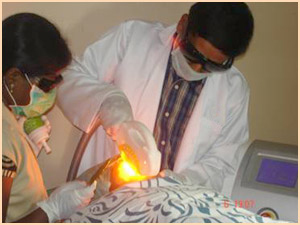
Intense Pulse Light Therapy
Photographs of Acne and Acne scars treated:
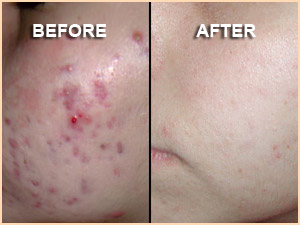
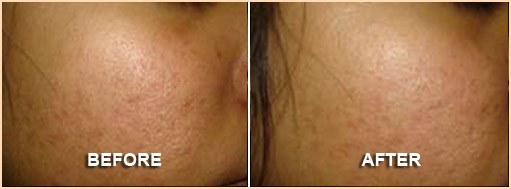
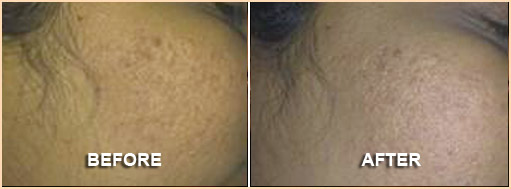

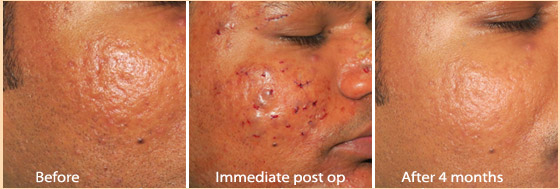

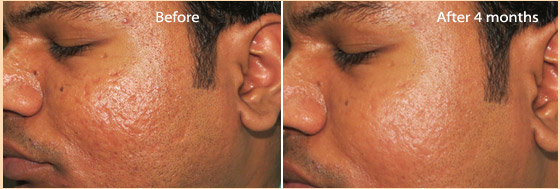
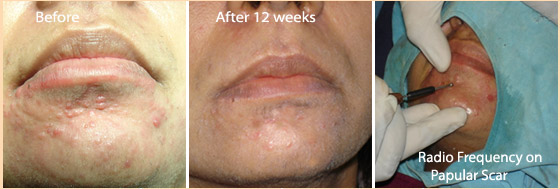
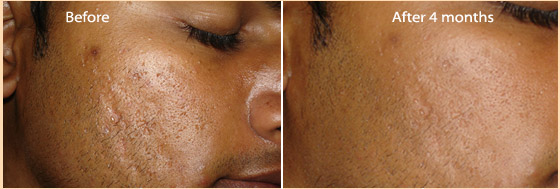
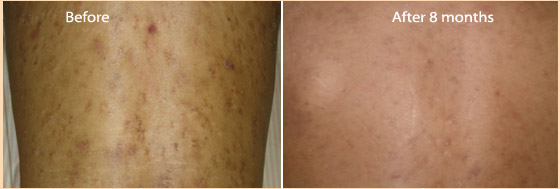
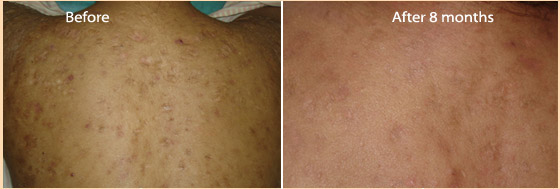
What is Hyperhydrosis?
Hyperhidrosis means “excessive sweating”.
Sweating is one of the most important ways in which the body loses heat. However, people with hyperhidrosis produce sweat in amounts far greater than needed to control their temperature.
There are two main types of Hyperhidrosis:
- Focal hyperhidrosis is the more common type involving excessive sweating in the armpits/ underarms and on the feet & hands.
- Generalized hyperhidrosis affects the whole body. It is much less common and is usually caused by another illness such as an infection, diabetes or when the thyroid gland is overactive. The excessive sweating usually stops when the illness is treated.
What factors make the sweating worse?
- Anxiety - can exacerbate the situation for many sufferers. A common complaint of patients is that they get nervous because they sweat.
- Certain foods & drinks
- Nicotine,
- Caffeine,
What are the social effects of Hyperhydrosis?
Excessive sweating impedes the performance of many routine activities. Things like driving, taking tests and simply grasping objects are severely hampered by sweaty hands. In addition, many careers present challenges for hyperhidrosis sufferers, such as for cook/chefs, doctors, and people working with computers. However, it is the social embarrassment that most hyperhidrosis sufferers find most troubling.
What are the treatment options available?
- Topical agents such as aluminum chloride in ethyl alcohol may be indicated for axillary sweating.
- Short-term courses of Anticholinergic drugs are also useful in severely afflicted patients but the side effects of dry mouth, drowsiness and constipation frequently occur.
- Super-antiperspirants may be of some help. These are essentially super strength formulas of regular underarm antiperspirants. The active ingredient, aluminum chloride, actually reduces the sweat output (unlike deodorants, which just deal with odor).
- Botox - Today, there's a safe, effective treatment that has very little risk or any significant side effects. This treatment uses muscle-relaxing injections.
- Iontophoresis - The affected area is placed in a device that has two pails of water with a conductor in each one. The hand or foot acts like a conductor between the positively- and negatively-charged pails. As the low current passes through the area, the minerals in the water clog the sweat glands, limiting the amount of sweat released.
- Relaxation and meditation: Relaxation techniques have been tried with limited success.
- Hypnosis: Hypnosis has been used with limited success.
- Percutaneous Sympathectomy: A minimally invasive procedure in which the sympathectomy nerve is blocked by an injection of phenol.
How does Botox work?
The treatment involves the injection of tiny amounts of muscle relaxant / Botox in a grid pattern over the affected skin. There is a small amount of discomfort during the treatment, but no anaesthetic is required. The effects last from 4-9 months depending on the site of injections.
What are the benefits of Botox?
- The treatment becomes effective within several days, leading to a significant reduction in the amount of sweating – Underarms, Palms & Soles
- The improvement can last around four to nine months.
- The treatment can be repeated as often as necessary.
- There is no downtime
- Easily accessible
Treatment Advice:
- Meet with our dermatologist and have your condition evaluated.
- There are many simple options available today to control excessive sweating.
Corn is an area of thickened skin due to direct pressure on a small area, especially seen on the feet. Corns are removed through a simple and safe office procedure to completely remove the corn. We offer either surgery or cryotherapy which will be decided after discussing with the patient. These prevents recurrence, and multiple corns can be removed. Corrective footwear reduces recurrence.

Cryotherapy is a simple office procedure utilizing liquid nitrogen, delivered by a special tip application, to freeze epidermal lesions.

Various conditions treated by Cryotherapy:
- Seborroeic keratosis
- Warts
- Small tumors on the face.
- Keloids
- Hypertrophic scar
- Pyogenic Granuloma
Liquid nitrogen is considered a surgical destruction of a lesion, that uses a freeze/thaw cycle for 30 seconds. After the treatment, the lesion will swell for a few hours to days, then scab and eventually it should fall off. The entire process can take anywhere from one to three weeks to see the result. Often the lesion may need to be treated again in 20 to 30 days.
Mole (Nevi)

Moles (nevi) are growths on the skin. Moles are very common. Most people have between 10 and 40 moles. A person may develop new moles from time to time, usually until about age40.
About one out of every ten people has at least one unusual (or atypical) mole that looks different from an ordinary mole. Dysplastic nevi are more likely than ordinary moles to develop into a type of skin cancer called melanoma. Because of this, moles should be checked regularly by a doctor, especially if they look unusual; grow larger; or change in color, outline, or in any other way. The removal of the entire mole or a sample of tissue for examination under a microscope is called a biopsy which is recommended for confirming melanoma.
Mole Removal:
There are various methods for removing moles. Some of the common methods used are Radiofrequency or Laser Excision. Some dermatologists prefer to shave the mole and then excise. The method depends on the type of mole.
Protection from the Sun:
Always use a sunscreen / sunblock. Apply it at least 20 mins before sun exposure.
Mole excision:
Compound nevus (mole) on upper lip in a patient who had applied home made irritants adviced by her friends and came to us with scar around mole


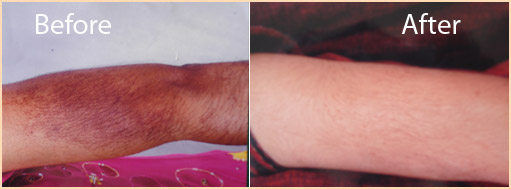

What are Keloids?.
Keloids are skin-covered outgrowths that occur at sites of injury. They are warm, itchy, pink and at times painful.

Are they common?
It is estimated that 15 to 20% of the population are keloid prone, however not all keloids are due to piercing and not all pierced areas develop keloids.
Why does a keloid form?
When a deep injury such as piercing occurs, Collagen and elastinfibres in the dermis break and part. In the process of healing, new fibres are formed and deposited by cells called fibrocytes in the dermis. Normal healing stops when adequate fibres are produced. In the keloid prone, the chemical signals that regulate fibrocytes may be defective and the deposition of new fibre does not stop when it must. This results in the accumulation of a large heap of fibres covered by epidermis. This growth is visible to us as a keloid.
What can one do when a keloid does occur?
- The most important thing is to not sit on the problem and attempt to wish away the keloid. Consult your doctor.
- Medicines can be injected to melt the keloid
- Keloids can be frozen and then a medicine can be injected
Laser can be used to remove the keloid at once, and the results are good in experienced hands. The doctor decides on the technique depending on the size, site, number of keloids and age of the keloid, age and general health of the patient.
Is keloid surgery a permanent cure?

Surgery does not influence the keloid-forming tendency, which is genetic. Please note that genetic means controlled by genes and not necessarily hereditary. After a keloid is removed, the operated area is at risk of becoming a keloid again. The doctor will ask you to follow up for a few visits and inject a fibrocyte inhibiting substance, or prescribe a local application to do the same. Keloid surgery can offer a flat symptom free area of shiny skin, but cannot restore it to the original appearance of surrounding normal skin with its pores, hairs and lines.
Electrosurgery and Radiofrequency surgery
At DERMAVISION, we use the advanced Electrosurgery and Radiofrequency to remove unwanted skin growths (both benign and malignant lesions).

Electrosurgery is a simple procedure with quick recovery time, a safe cosmetic procedure and a good economical alternative to laser. It is useful for treating a variety of skin lesions. This is the most commonly used equipment.
Various Conditions Treated by this Equipment:
- Seborroeic keratosis
- Skin tags(Acrocordons), DPN
- Warts
- Telangiectasias
- Angiomas
- Small Tumors on the face
- Syringoma
- Millia
- Xanthelasma
- Epilation
Post treatment care
It includes washing with a mild soap and water and then applying antibiotic ointment. Minimal bits of dry skin remain which should never be peeled off or scratched for 2-3 days after which they fall off revealing a clear beautiful skin, free of blemishes.

Molluscum contagiosum is a very common viral infection of the skin caused by a DNA poxvirus and affects both children and adults.

The virus that causes this condition enters the skin by person-person contact and multiplies within the skin cells producing enlargement of these cells and thereby forming small bumps which are smooth-surfaced and pearly white in colour, usually 2-6 mm in diameter (range 1-15 mm). They may be present in groups or widely spread on different parts of the body. The virus, after entry into the skin starts producing the bumps in1- 6 months and continues to do so for 6 months to 2 yrs. Within this period, a fresh crop can occur every 2-4 weeks.
Molluscum contagiosum is common in two age groups. The first is in childhood, when spread occurs from direct skin contact. , the commonest way for adults to get it is from children who bring it home from school. In adults, it may occur at times as a sexually transmitted disease. Molluscum contagiosum is generally self-limited and heals after several months or years. This period is unpredictable though it is roughly between 6 months to 2 yrs. Any one lesion is present for about 2 months. However, to prevent autoinoculation (spread of infection from a previous lesion to a new site in the same individual) or transmission to close contacts, therapy may be beneficial..
Complications of molluscum contagiosum include irritation, redness and secondary infection by bacteria. The complications may occur as a result of frequent touching or manipulation.The common goal of the different treatment methods is the destruction of the existing lesions. Commonly used treatments are application of a medicated cream, freezing with liquid nitrogen and curettage (surgical removal). There is a chance of recurrence of lesions even with treatment of existing ones. Hence monthly review for a period of about 1 year maybe required.
Warts are very common growth caused by the human papilloma virus and almost 1 in 20 persons will get a wart some time in his or her life.
Warts can occur anywhere, but are most common on the hands, feet, face and genitals.
Genital warts are sexually transmitted.
Warts are seen as dry rough 0.5 to 2 cm firm growths that are painless, even when touched or manipulated. They are generally seen as domed or flat-topped growths. When they occur on the genitals, they appear fleshy and pink.
The reason why dermatologists choose to treat warts is because, for the duration for which they do last, they can spread to other parts of ones own body, be a source of infection to others, cause pain if at a pressure site or embarrassment if located in an exposed area.
Depending on the location and type of warts, the treatment options include application of a wart medication at home over a 16 to 20 week period, freezing with liquid nitrogen, electrical cautery or one of a variety of lasers.
Given the fact that the wart virus could seed any area of the skin and wart is only a visible location, treatment of a wart is no guarantee against new warts occurring at the same or a different site. Hence, after treatment it is customary to review once a month for about 3 months to check for new warts if any and treat them. If no new warts are detected for 3 consecutive months, it constitutes reasonable (though not certain) proof of cure.
One should undergo wart treatments bearing this in mind.


A variety of skin growths are loosely referred to as warts by the untrained. Your Dermatologist is best trained to diagnose and advice you.
Vitiligo is pigmentation disorder in which melanocytes (the cells that make skin color) in the skin are destroyed. As a result, white patches of skin appear on different parts of the body. The hair that grows in areas affected by Vitiligo usually turns white.
It is a common condition that affects upto 1 percent of the general population, which means that in a place like Bangalore with 60 lakh people, about 60 thousand people are expected to have it. Vitiligo can cause extreme distress and psychological depression to sufferers because of its obvious unusual appearance. It affects people of both gender and all races. It can begin at any age, however, about fifty percent of people with Vitiligo develop it before the age of twenty five. You cannot get Vitiligo from someone who is affected. It is not infectious or contagious. But it can be hereditary (parents to their children).
The goal of treating Vitiligo is to restore the function of the skin and to improve the patient's appearance. The choice of therapy & duration of treatment depends on the number of white patches and how widespread they are and on the patient's preference for treatment. it can be cured as early as 3 to 4 months and takes longer upto 18 months for larger patches. Each patient responds differently to therapy, and a particular treatment may not work for everyone.
Treatment options available in Dr. Umashankar's Dermavision®.
| Medical Treatment | Adjunctive Treatments | Surgical Therapies |
| Phototherapy | Cosmetic camouflage DERMACOLOR | Miniature punch graft |
| Topical PUVA | Counseling and support | Split thickness graft and Ultra thin Epidermal Skin Graft (UTEG) |
| Oral PUVA | Suction Blister graft | |
| Narrow band UVB | Autologous melanocyte transplants |
Photographs
Autologous melanocyte transplants:
![]()
Split thickness graftSeparation of melanocytes in Autologous melanocyte Transplantation
![]()
Well trained assistants in DERMAVISION engaged in Autologous melanocyte transplantation
![]()
Pellet collection
![]()
Transplanting melanocytes under collagen dressing
Clinical photographs
Therapeutic Tattoo in vitiligo on left axilla:
![]()
Although color mismatch persists, many patients feels darker colored lesions are preferred over white patches.
Suction Blister graft
Case 1: Vitiligoon Upper lip
Case 2: Vitiligo on Right upper eyelid
Case 3: Lower lip
![]()
![]()
Case 4: Lower lip
![]()
Autologous Melanocyte transplantation
Case 1: Right wrist
![]()
Case 2: Both legs
![]()
Case 3: Both lower legs
![]()
One needs to remember that not all white patches are Vitiligo. As stated earlier, pale or white patches can result for a variety of skin diseases ranging from birthmarks to leprosy. Your Dermatologist is the best person to guide and advice you. You can read more about vitiligo at www.vitiligofoundation.orgORvitiligosupport.comDo come back to us with questions, and advise/ demonstration of cover-up.
![]()
![]()
Quick Links
 |
||
 |
||
 |
